

- Documentation
- Table of contents
- AKC
- Introduction
- Airframe Creation
- Technological Problems
- Experimental plant
- Building plant
- Conf. Development
- Aerodynamic Designing
- Algorithms of control
- Guidance & control
- Stand for training
- Training center
- Horizontal flight tests
- Crew on board
- Auto Landing complex
- Structure
- Payload bay
- Metallic material
- Non metallic material
- Non metallic material
- Cabin assembly
- Thermal designing
- Thermal protection
- Heat protection
- Quartz fibre
- Computer designing
- Gas's dynamic
- Strength
- Basic direction
- Tech. preparation
- Technical diagnostics
- Methods & means
- Radio nav. support
- Information & controls
- Control of onboard equ.
- Electric power dist.
- Electromagnetic
- Antennas installation
- Auxiliary power unit
- Hydraulic system
- Cabin
- Safety
- Air transportation
- Automatic landing
- Exp. working out
- Return to space
- SPIRAL
- Analysis of concept
- Horizontal take-off
- BOR-4 & BOR-5
- MAKS multipurpose
- MAKS-D
- Thermal design
- Gas & thermal design
- Wing deflection
- Flight performance
- Maks structure
- Metal materials
- Advanced non metallic
- Information provision
- Onboard starting comp.
- Onboard control comp.
- Control organization
- Aerospace systems
- Economic investigations
- Triplane aircraft
- Technical inventions
- Scientific potential
- Triumph and tragedy
- Birds of a Feather?
- TsAGI wind tunnel
- Bibliography
| -The Mriya is destroyed. |
| -Shipping of Buran-KS to Sotchi. |
| -Antonov is no more. |
| -Buran is now a museum. |
| -New pictures of the blogger Ralph Mirebs. |
From SPIRAL to MAKS
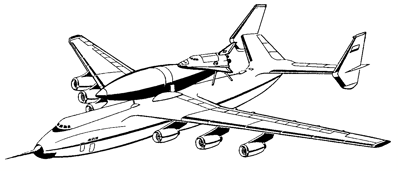
|

|
Practical cosmonautics (astronautics) was started on October 4, 1957, and reached a level of profitable application in a number of areas of activity about middle of 90s. These are primarily space communication systems, navigating, meteorology, remote probing of the Earth. The further development of this process is restrained by the high cost of payloads’ delivery into an orbit. Therefore, the cost reduction of transport operations is the major task, which the creators of space technology encounter. The main direction of this problem solution is creation of Reusable Space Transport Systems (RSTS).
SPIRAL project developed in Design Bureau, named after A.I. Mikoyan, in 1965…1975 was one of the first projects of reusable space transport systems, which was developed to the stage of creation of a manned orbital spaceship’s prototype and its flight tests in subsonic speed range.
The first implemented RSTS projects are Space Shuttle, ENERGIA-BURAN, Pegasus. A part of these systems components are the articles of reusable application. However, these systems did not give a cardinal solution of the problem, as the cost of their maintenance was enough high.
Presently the intensive research on the RSTS concepts of next generation is carried out in many developed countries. Special attention is focused on the economic efficiency of application, which is mainly determined by capabilities of accomplishment of different target tasks.
In our country there are certain limitations on space activity, superimposed by the features of its geographical position. Located at high latitudes, launching sites Plisetsk and Baikonur can not provide the objects injection directly into the low-height orbits with an inclination less than 63° and 51° accordingly. Therefore, the launch of communication satellites into geo-stationary orbit from our launching sites requires 2.5 times higher fuel expenditure, than from the West-European launching site Kourou, located in 7° northern latitudes.
At further development of space activities such tasks become actual as emergency saving of crews of manned space objects and operative inspection of space objects. The execution time of such tasks for a launch system of conventional vertical start can reach up to 4 days, which is completely unacceptable. The operative solution of the task of emergency flight to orbital object (up to 12 hours), and also direct launch into orbits with optional inclination can be provided only by a reusable space transport system of horizontal takeoff, which uses a carrier-plane as the first stage and mobile start. It allows to remove constraints, superimposed by allocation of domestic launching sites, and in addition gives a capability of basing on equipped airfields in different regions of the Globe. Now the most well known projects of such systems have included the following: SPIRAL project of the 60s (USSR); Sanger project (Germany); MAKS (Russia, Ukraine).
Within 20 years of its existence, NPO MOLNIYA have accomplished researches and developments on a wide set of projects of reusable space transport systems including air units in their structure. The list of basic designs of these systems is displayed below in the scheme, prepared by leading designer Kutyakin Ye.P.
The results of many years researches show that nowadays MAKS project with the most powerful in the world subsonic AN-225 MRIYA carrier-plane in the greatest degree meets the requirements set to advanced RSTS. These requirements are imposed both to the cost of creation and launch of 1 kg payload and to the efficiency of solution of various missions and ecological criteria. Therefore, the questions of designing MAKS and characteristics of this system are given the greatest notice in this section of book. It is shown that MAKS performances can be considerably improved in the future due to creation of super heavy HERACLES twin-body carrier-plane under the tri-plane scheme.
Some articles of this section contain methodological results, generalizing the practical experience have been acquired in the SPIRAL, BOR, BURAN and MAKS projects.
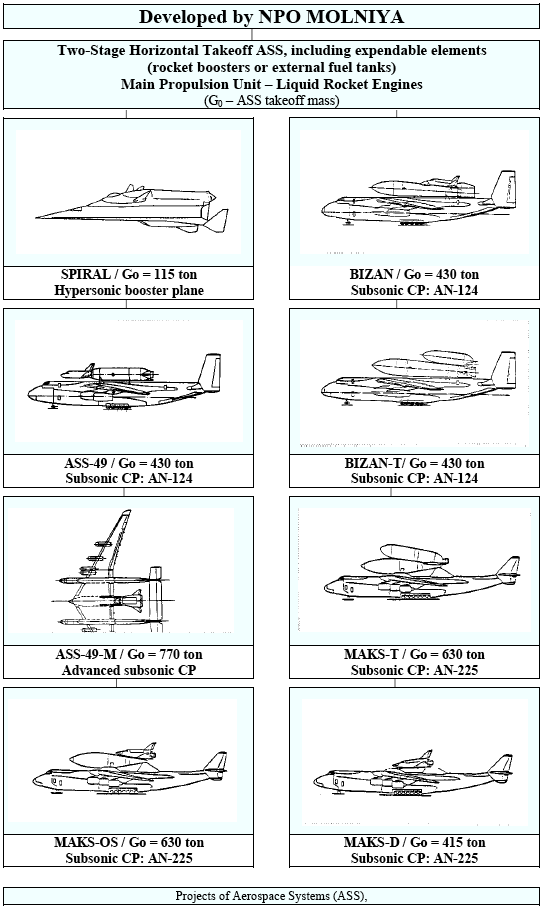
|
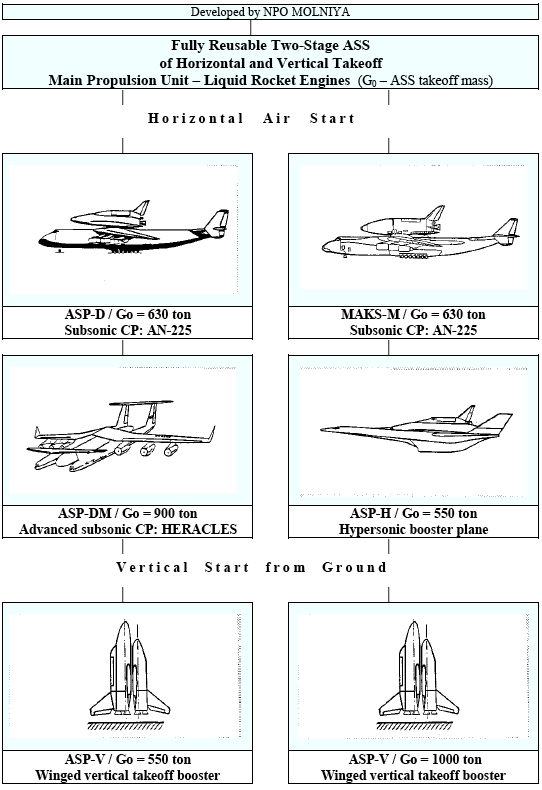
|
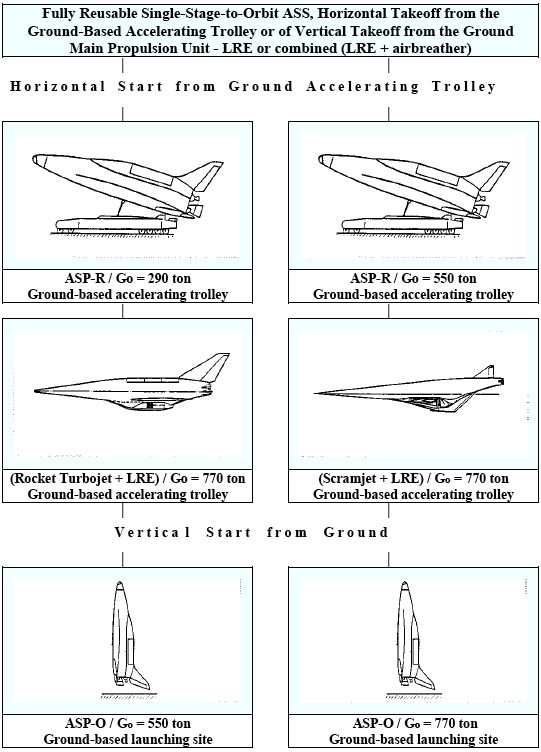
|
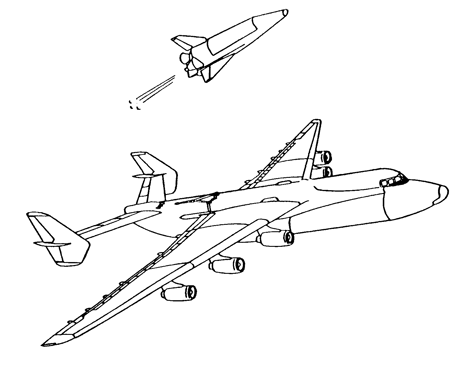
|
|
MAKS-D Experimental Aerospace System – the technologies’ demonstrator for advanced RSTS and the MAKS prototype |